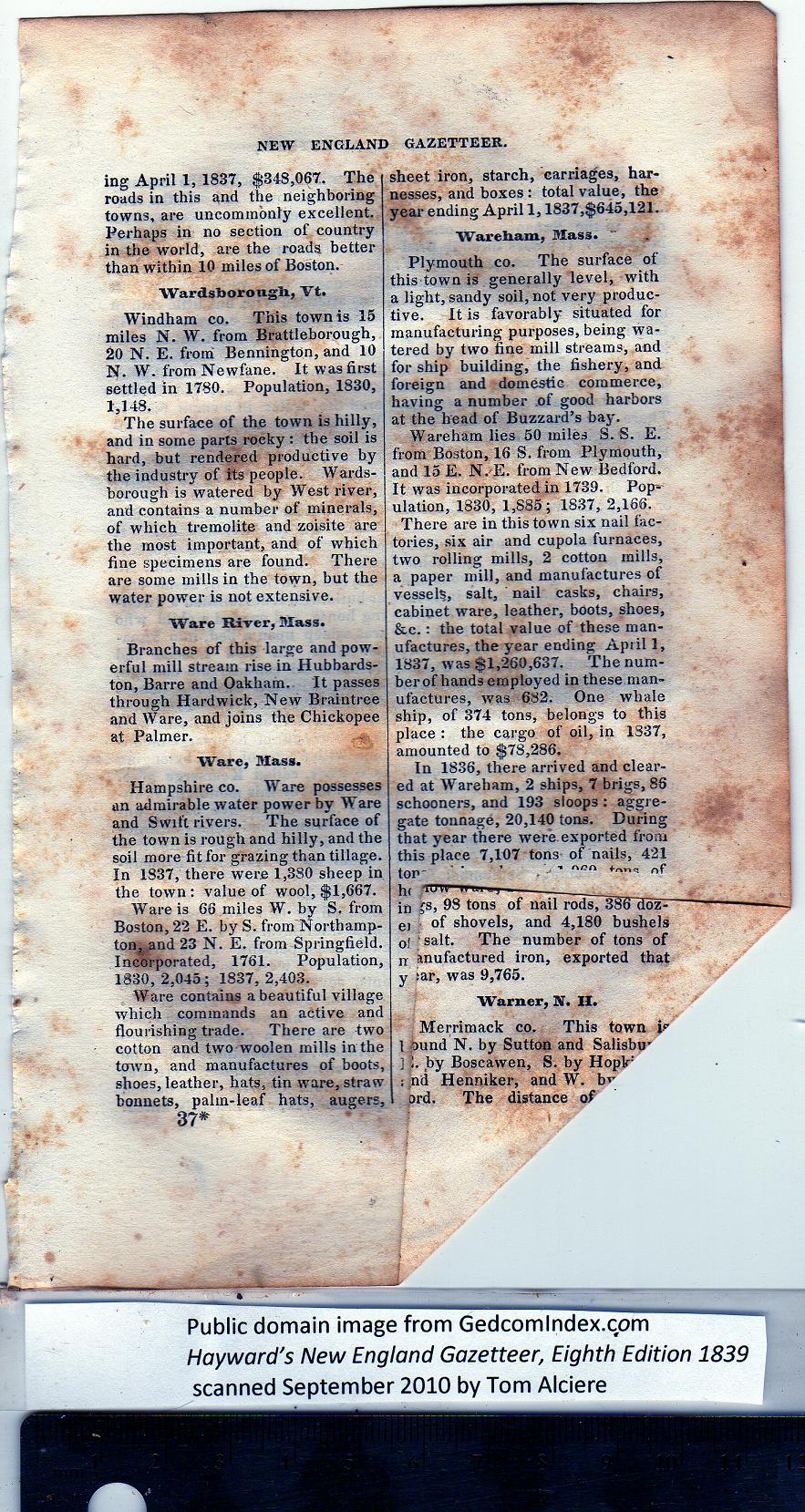|
ing April 1, 1837, $848,067. The
roads in this and the neighboring
towns, are uncommonly excellent.
Perhaps in no section of country
in the world, are the roads better
than within 10 miles of Boston.
Wardsborough, Vt.
Windham co. This town is 15
miles N. W. from Brattleborough,
20 N. E. from Bennington, and 10
N. W. fromNewfane. It was first
settled in 1780. Population, 1830,
1,148.
The surface of the town is hilly,
and in some parts rocky : the soil is
hard, but rendered productive by
the industry of its people. Wards-
borough is watered by West river,
and contains a number of minerals,
of which tremolite and zoisite are
the most important, and of which
fine specimens are found. There
are some mills in the town, but the
water power is not extensive.
Ware River, Mass.
Branches of this large and pow-
erful mill stream rise in Hubbards-
ton, Barre and Oakham. It passes
through Hardwick, New Braintree
and Ware, and joins the Chickopee
at Palmer.
Ware, Mass.
Hampshire co. Ware possesses
an admirable water power by Ware
and Swift rivers. The surface of
the town is rough and hilly, and the
soil more fit for grazing than tillage.
In 1837, there were 1,380 sheep in
the town: value of wool, $1,667.
Ware is 66 miles W. by S. from
Boston, 22 E. by S. from Norihamp-
ton^and 23 N. E. from Springfield.
Incorporated, 1761. Population,
1830, 2,045; 1837, 2,403.
Ware contains abeautiful village
which commands an active and
flourishing trade. There are two
cotton and two woolen mills in the
town, and manufactures of boots,
shoes, leather, hats, tin ware, straw
bonnets, palm-leaf hats, augers,
sheet iron, starch, carriages, har-
nesses, and boxes: total value, the
year ending April 1,1837,$645,121. |
Wareham, Mass. "
Plymouth co. The surface of
this town is generally level, with
a light, sandy soil, not very produc-
tive. It is favorably situated for
manufacturing purposes, being wa-
tered by two fine mill streams, and
for ship building, the fishery, and
foreign and domestic commerce,
having a number of good harbors
at the head of Buzzard’s bay.
Wareham lies 50 miles S. S. E.
from Boston, 16 S. from Plymouth,
and 15 E. N.-E. from New Bedford.
It was incorporated in 1739. Pop-
ulation, 1830, 1,885; 1837, 2,166.
There are in this town six nail fac-
tories, six air and cupola furnaces,
two rolling mills, 2 cotton mills,
a paper mill, and manufactures of
vessels, salt, nail casks, chairs,
cabinet ware, leather, boots, shoes,
&c.: the total value of these man-
ufactures, the year ending Apiil 1,
1837, was $1,260,637. The num-
berof hands employed in these man-
ufactures, was 682. One whale
ship, of 374 tons, belongs to this
place : the cargo of oil, in 1337,
amounted to $78,286.
In 1836, there arrived and clear-
ed at Wareham, 2 ships, 7 brigs, 86
schooners, and 193 sloops : aggre-
gate tonnage, 20,140 tons. During
that year there were.exported from
this place 7,107 tons of nails, 421
top' ’ "* nf
in ^Wtons' of nail rods73S6Mdz^
e, of shovels, and 4,180 bushels
of salt. The number of tons of
it anufactured iron, exported that
y jar, was 9,765.
Warner, BT. II.
Merrimack co. This town if
\ ound N. by Sutton and Salisbir
j h by Boscawen, S. by Hoplr
: nd Henniker, and W. bv
prd. The distance of |
